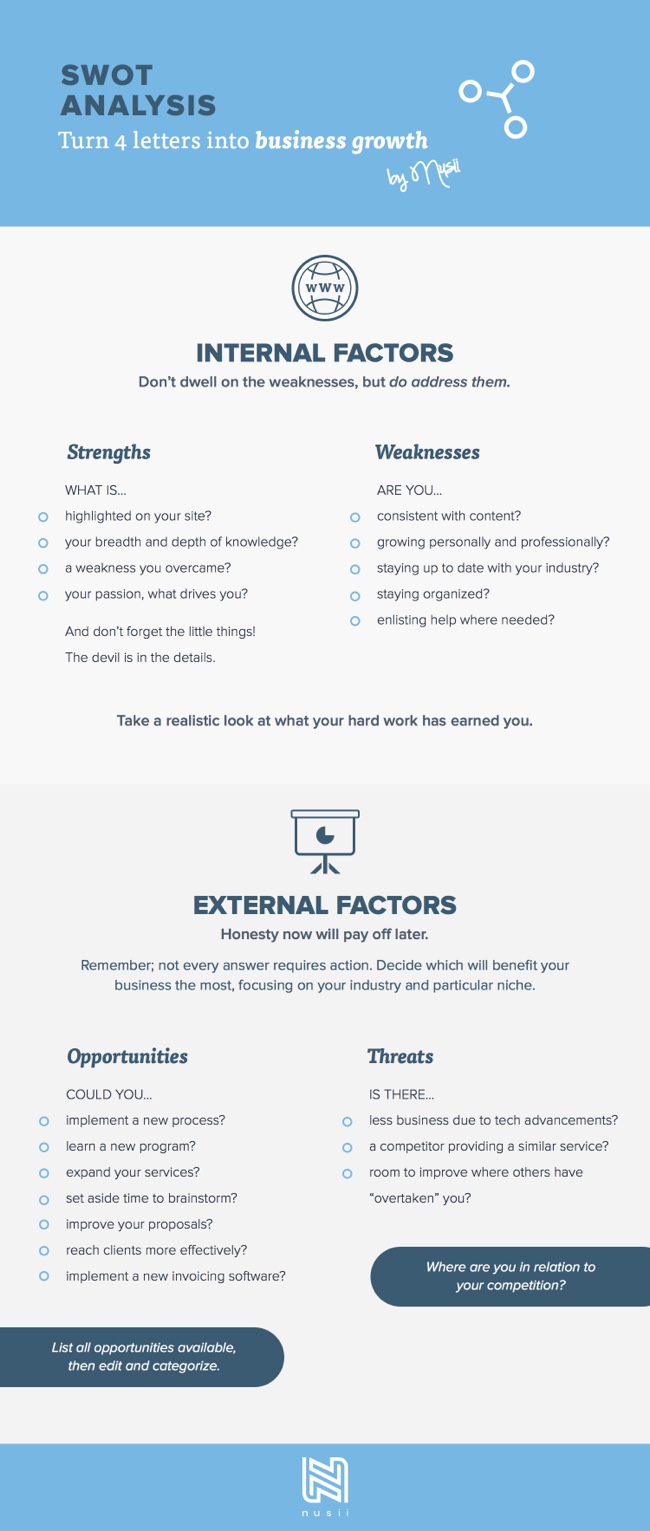SWOT Analysis: Turn 4 letters into business growth

SWOT analysis began as a way to analyse internal and external factors that can directly or indirectly affect businesses. Internally, it looks at Strengths and Weaknesses; externally at Opportunities and Threats. Do you know what your current strengths and weaknesses are, or how opportunities and threats can affect your business? No? Read on to find out how SWOT analysis can get your business into gear.
INTERNAL ANALYSIS
What are your strengths?
Strengths focus on the positive aspects of yourself, your brand, and your company. What makes you stand out from other businesses? Don’t be shy! This is the time to take a realistic look at what your hard work has earned you. It could be the sense of humor in your writing, your cutting edge design style, or your off the wall marketing tactics. Write them all down, and don't forget the little things. Little details matter too!
- What is highlighted on your website?
- What's your breadth and depth of knowledge in a field?
- What are you passionate about? What drives you?
- Did you conquer procrastination this month?
Where could you grow?
Now it’s time for the hard part. Weaknesses focus on the negative aspects of your business. Being honest with yourself will pay off long term. Address any problems that can advance your business. While dwelling on the negatives isn't very productive, make sure you look at what you can do to mitigate them. Your business will become far stronger because of it.
- Are you growing personally and professionally?
- Is consistency, well, not consistent?
- Is your knowledge outdated?
- Could you take some courses or learn new software to stay relevant?
- Do you need to enlist help during your busier seasons?
- Are you staying organized?
EXTERNAL FACTORS
External factors are best utilized with specific competitors in mind. Yes, look at your industry as a whole, but pick your top competitors. Then, use Opportunities and Threats to see where you need to step up your game.
What are your opportunities?
Opportunities focus on the positive, untapped potential in your industry. Start thinking about areas or niches you could enter. New markets can take your career beyond what you first imagined for yourself when you started out.
List all the opportunities available. Don’t filter at this point, just list everything you can think of. Then, begin to break it down by category; for example "Business" and "Creative", then break them down further into goals and objectives.
This can feel overwhelming at first, but try to think the big picture in mind. We're looking at the long-term here. If you love planning months or even years out, you could spread your categories throughout the year. If that sentence just made you shudder, try breaking them down again into short and long-term goals. Keep that list handy! Each week, month, or when you’re feeling motivated, pull it out and see if you can accomplish something.
Business goals:
- Implement a new invoicing software.
- Reach clients better by using an email subscription service.
- Improve your proposals.
Creative goals:
- Implement a new process.
- Learn a new program that could expand the services you provide.
- Set aside time to brainstorm each week.
- Begin a new service.
What could be threatening your business?
Threats are the negative aspects of you in relation to your industry. Again, this means you need to be honest with yourself. Where are you currently placed in relation to your competition? Realizing where your competition is coming from is key to surpassing "threats" that could put your career at risk.

- Is someone else advertising the same service (and doing a better job)?
- Are competitors using a new website, social network, or technology that will open up new business avenues for them?
- Is your niche becoming automated, could your business disappear?
Clarification: It’s important to note that not every answer requires action. Even if others are hopping on a product bandwagon it doesn’t mean you have to. Remember, you can’t serve everyone. Think of your ideal client, a customer persona can help with this, - if they would use a service and find value in it, then it could be something worth adding. If you can add a niche service to your customers, it can help fund your own passion projects (side projects). These new services can help protect your business in the future, and separate you from the pack.
As with weaknesses, it won't help you to get stuck on what other businesses may be working on. Apprehension to continue with your current goals is a threat in itself. Be bold, and forge on!
A new take on an old idea
In college, I had a marketing professor who insisted we refer to SWOT as TOWS. He argued that we cannot adequately look at our strengths and weaknesses before analyzing outside forces. After all, our strengths and weaknesses are based on others’ strengths and weaknesses.
He had a point.
I’ve realized that I tend to already look at the external factors as a comparison, which is not linear. Instead, a SWOT analysis is like looking at everything at once. If we want to approach this linearly, TOWS could be an even better way to approach this.
Your turn!
- Have you ever completed a SWOT analysis for your business?
- Do you think freelancer businesses can benefit from a SWOT analysis?
